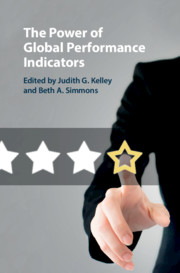Book contents
- The Power of Global Performance Indicators
- The Power of Global Performance Indicators
- Copyright page
- Contents
- Figures
- Tables
- Contributors
- Preface
- 1 Introduction
- Part I Ratings, Rankings, and Regulatory Behavior
- Part II The Normative Influence of Ratings and Rankings
- Part III Beyond and Within State
- 9 Can Blacklisting Reduce Terrorist Attacks?
- 10 Assessing International Organizations
- Part IV Skeptical Voices
- Index
- Chapter 3: Appendices
- Chapter 4: Appendices
- Chapter 5: Appendix
- Chapter 6: Appendix
- Chapter 7: Appendix
- Chapter 8: Appendix
- Chapter 10: Appendix
- Chapter 11: Appendix
- Chapter 12: Appendix
- References
9 - Can Blacklisting Reduce Terrorist Attacks?
The Case of the US Foreign Terrorist Organization (FTO) List
from Part III - Beyond and Within State
Published online by Cambridge University Press: 28 February 2020
- The Power of Global Performance Indicators
- The Power of Global Performance Indicators
- Copyright page
- Contents
- Figures
- Tables
- Contributors
- Preface
- 1 Introduction
- Part I Ratings, Rankings, and Regulatory Behavior
- Part II The Normative Influence of Ratings and Rankings
- Part III Beyond and Within State
- 9 Can Blacklisting Reduce Terrorist Attacks?
- 10 Assessing International Organizations
- Part IV Skeptical Voices
- Index
- Chapter 3: Appendices
- Chapter 4: Appendices
- Chapter 5: Appendix
- Chapter 6: Appendix
- Chapter 7: Appendix
- Chapter 8: Appendix
- Chapter 10: Appendix
- Chapter 11: Appendix
- Chapter 12: Appendix
- References
Summary
Within global security governance, a number of governments monitor and label certain organizations as “terrorist groups” with the aim of curtailing their capacity. The most prominent example of this is the U.S. Foreign Terrorist Organization (FTO) list. Under what conditions is FTO listing an effective counterterrorism tool? We develop a theory of blacklisting in the context of FTOs, arguing that the impact of FTO designation depends on the types of support terrorist organizations rely on. We theorize that FTO blacklisting has capacity-curtailing effects on terrorist groups when funding sources are vulnerable to detection, sanctions, and stigmatization. Specifically, we hypothesize that groups with private funding (e.g. charities, diaspora networks) are more likely to reduce attacks after FTO designation, compared to groups with other funding sources such as criminal activities. Analysis of data on terrorist organizations between 1970 and 2014 takes into account the political processes of listing and provides support for the argument. The findings highlight the importance of understanding the nature of the target in evaluating the performance of global indicators.
- Type
- Chapter
- Information
- The Power of Global Performance Indicators , pp. 271 - 299Publisher: Cambridge University PressPrint publication year: 2020



